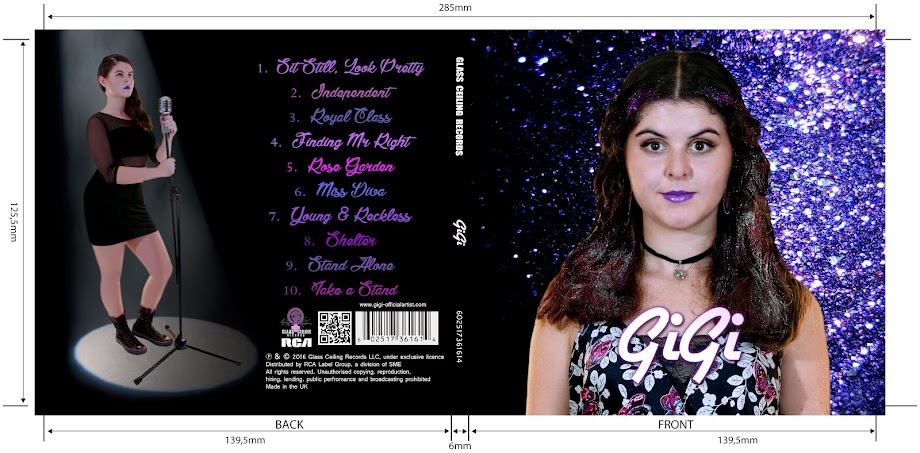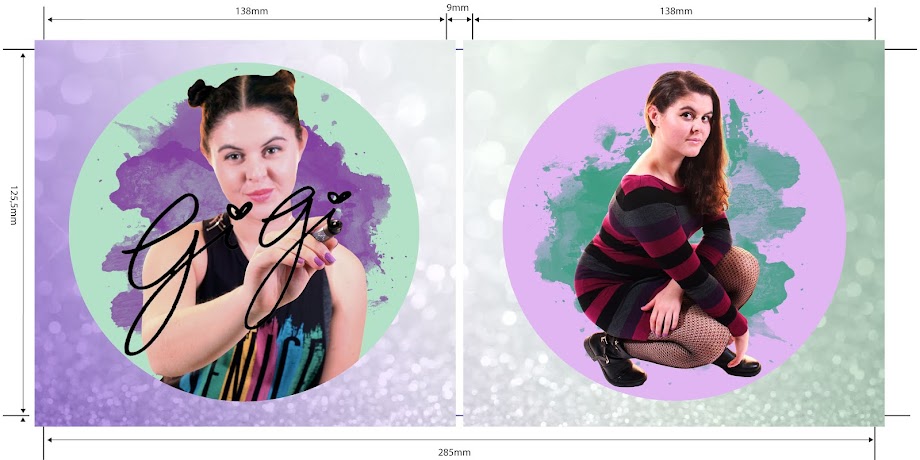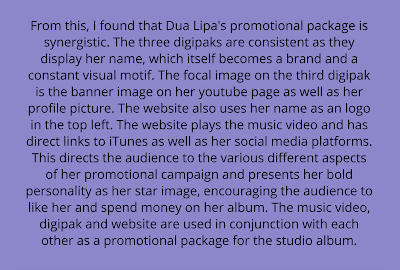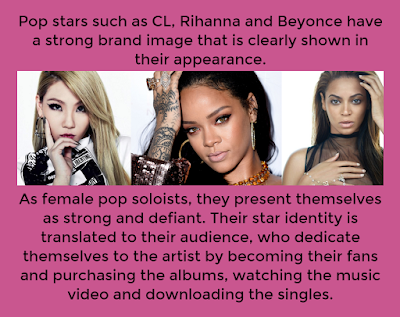Throughout the production of our music video, album cover, and website for our pop artist we conformed to, further developed, and challenged pop genre conventions. We stuck to typical forms and conventions in order for our products to be accessible to our audience and gratify their needs as consumers. However we also challenged and broke some conventions to keep our content fresh and exciting for our target audience, so as to grab their attention and raise appeal.
Music video conventions
Our music video conforms to many forms and conventions of the pop genre but we developed them further with hyper reality and multiple setups. We also challenged conventions such as voyeurism and the male gaze by deliberately choosing not to linger on the female body. I have incorporated music video theories into our music video from the beginning of our project. This is positively influenced the production of our music video because we were able to construct the basis for the form of our music video.
I have applied theories about conventional music videos from Simon Frith, Andrew Goodwin and Carol Vernallis.
Simon Frith
According to Simon Frith, music videos tend to be categorised into three types: performance, narrative or conceptual. The categories are easily identifiable to audiences and they can often form first impressions based on whether the music video meets their expectations or not.
Avril Lavigne, a pop-rock star, can be seen singing into a microphone, throwing her hands in the air and lunging towards the camera in this scene from her music video "Girlfriend"
Here, GiGi is singing to the camera. She directly addresses the audience just like Avril Lavigne and she sings into a microphone. She does a variety of movements such as pointing to the camera and spreading her arms out.
A narrative-based music video follows a storyline or a visual sequence. Narrative music videos tend to use Classical Hollywood editing techniques to make the sequence as continuous as possible.
An example of a narrative music video is Carly Rae Jepsen's "Call Me Maybe". She is encouraged to help her crush clean his car after she spies on him from afar.
We developed our narrative to be very performance based
Our music video, on the other hand, is not a typical narrative music video. The dolls are part of a side story that runs adjacent to GiGi's performances. In order to suit the hyper-realistic music video, it was important that this part didn't seem too real. Therefore, it does not fully adhere to standard narrative music videos.
Most conceptual music videos are typically full of strong visual imagery and symbolism.
Our music video is not symbolically conceptual but it is thematically conceptual. For example, we use different setups to visually show that it is a different concept for each character. This was drawn from Destiny's Child music video for "Say My Name".
Andrew Goodwin
Andrew Goodwin, in Dancing in the Distraction Factory (1992 Routledge) has identified the following features of music videos:
 |
| We conform to most of the conventions |
1. Genre characteristics
Our music video demonstrates some of the pop music genre characteristics such as dressing the set in bright and bold colours which are typically associated with a positive and happy vibe. For example, Meghan Trainor's music video for "All About That Bass" is bright lit with a pastel colour scheme that connotes the bubblegum-pop genre of the music video and song.
 |
| All About That Bass |
Bright colours in our music video
Pop music videos also tend to include dancing of some kind. Another convention of pop music videos is that they use fast paced editing and intercut between shots. An example of both of these conventions is CLC's "Oh No No"
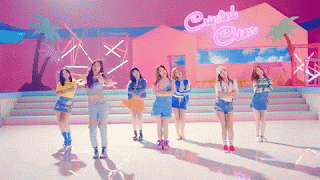 |
| CLC's Oh no no |
Our music video's visuals come from the track's lyrics. There is a very strong relationship between the lyrics and the visuals because we generated the ideas for the visuals from the lyrics of the song. An example of this is when GiGi is dressed as a puppet when the song plays "I don't wanna be the puppet that you're playing on the string".
 |
| Link between lyrics and visuals at puppet setup |
3. Relationship between music and visuals
We have cut to the beat of the music. This is clear to see in the first section of our music video where all of our cuts are to the beat and GiGi even walks to the beat.
4. Beauty shots of the artist
Beauty shots, also known as the money shots, are a necessary requirement to the institutions. The record label will need beauty shots in the music video in order to promote the artist's look and appearance.
 |
| Beauty shots |
We chose to challenge this convention because we felt that it did not match with GiGi's personality and what she stands for. We chose not to use the male gaze or the notion of looking but instead, allowed GiGi to own her body and her sexuality and be in control of the camera's gaze.
 |
| GiGi is in control |
However, we did linger on body parts such as the lips and the side of her face. We also chose to film a shot of GiGi opening her eyes at the beginning of the song as we were inspired by Foxes signature movement in "Let Go For Tonight"
 |
| Foxes "Let Go For Tonight" the notion of looking as she opens her eyes |
 |
| Close ups of the side of her face and the shot of her opening her eyes |
6. Intertextual reference
When the lyrics refer to Snow White, we cut to GiGi dressed up in the iconographic colours and sitting behind 7 cut-out dwarfs.
 |
| Intertextual reference to Snow White |
Carol Vernallis
In "The Kindest Cut - Functions and meanings of Music Video Editing (2001)", Carol Vernallis' theory centres around 4 key concepts that all relate to the way the music video is constructed:
- Narrative
- Editing
- Camera movement and framing
- Diegesis (the world of the music video)
1. Narrative
Our video is a visual response to the music as we took phrases from the song and generated an idea surrounding the lyrics. As a result, our music video is very literal and it doesn't require any deeper reading into the concept or storyline.
 |
| Narrative using Todorov's theory |
We made sure that the narrative ran through the video but we segregated it by intercutting them and dispersing the narrative within the performance. We broke music video conventions by using Todorov's theory to construct a storyline.
2. Editing
We edited our sequence to match the beat and implemented music video editing techniques that were 'foregrounded' to look extremely obvious to the audience and draw attention to itself.
However, we didn't completely conform to the convention of discontinuity editing and we even used Classical Hollywood editing styles such as placing our narrative shots in chronological order and adhering to the 180 degree rule (never places action behind our forward vision). We also used a lot of match on action, even between setups as we felt that it linked the two separate dimensions and made the sequence flow better.
3. Camera movement and framing
We used extreme long shots of GiGi walking and paired that together with close ups of the side of her face. This made the cuts more intense because the two shot types are polarising. We frequently use master shots in conjunction with close ups of the singer to give the audience a sense of the spacing in the studio and show how GiGi makes use of it.
4. Diegesis (the world of the music video)
We did not use much of the theory on diegesis but we slowly revealed the world of the singer as the song went on.
All in all, we were selective about the conventions that we chose to adhere to. We followed some of necessary conventions seen in music videos but we did not use discontinuous editing or anything that would confuse the audience such as leaving gaps in the audience's understanding of the diegesis.
This is because we wanted to cater for the needs of a young music video consumer who could easily follow our music video and understand it as it is at the moment. However, if we were to be less literal and more conceptual by leaving questions unanswered, a young child may not understand the message that we were trying to portray.
Post-modernist music video conventions
Post-modernist music videos tend to feature the following factors. I have underlined the features that we conform to and gave a brief explanation of how we used them.
1. Intertextuality
In Iggy Azalea's music video for "Fancy" the entire music video is an intertextual reference to the 1995 film, Clueless.
Here, Iggy uses the online dressing app that Cher uses in order to wear the iconic yellow Clueless outfit.
 |
| "Fancy" music video |
 |
| "Clueless' film |
They even parodied the scene in which they drive on the motorway in front of a large truck.
 |
| "Fancy" music video |
 |
| "Clueless" film |
 |
| Side by side comparison of the music video and the film |
In this example of intertextual references, Iggy Azalea has based her entire music video to revolve around the film.
In Meghan Trainor's music video for "All About That Bass', she makes a reference to "silicone barbie doll". She throws away the doll and shakes her head as if to disregard the idea of trying to look like the doll.
We reference to a Barbie doll in our music video because it is in the lyrics. (Goodwin: relationships between lyrics and visuals) We brought a doll in as a prop and GiGi rips its head off in defiance.
2. Parody
Meghan Trainor mocks the stereotypes regarding women being a good cook. In the lyrics, she says "I never learnt to cook, but I can right a hook" paired with the footage of her burning apple pies and lying on the floor. Similarly, we show GiGi attempting to flip a pancake and failing to do so, instead, getting it on her face and having to fan the flour off her face.
In Jennifer Lopez's music video for "Ain't Your Mama" she parodies the typical housewife stereotype. Here, she is seen to be doting on her husband while giving him the food that she prepared for him. She is also doing household chores such as ironing and cleaning the kitchen. In the song, she encourages women to stand up to men and say "I ain't your mama" (I ain't gon' be cooking all day/ I ain't gon' do your laundry)
Meghan Trainor's "Dear Future Husband" and GiGi's "Sit Still Look Pretty"
We conformed to the convention of using hyper-reality in our music video. We drew attention to the fact that our music video was not real. This is one of the reasons why we chose to shoot all of our footage in the studio, so that we lose a sense of realism that may be achieved with on-site footage.
When GiGi enters the doll's house, the audience know that it is impossible that she physically shrunk herself and interacts with a real life doll. Therefore, we were able to make it clear to audiences that the events were not realistic but we portrayed it in a way that appeared to make sense in a fictional sequence.
 |
| Going into the doll's house |
 |
| Coming out of the doll's house |
Similarly, when GiGi is shown in five different costumes and identities, she is displaying to the audience that she is simply playing a role and is aware of her own character.
In P!nk's music video for "Stupid Girls" she plays the role of multiple characters; including an angel, a devil, a blonde bimbo and a female president. In the video, she is displaying hyper-reality through her over exaggeration of playing each role.
P!nk playing the role of multiple personalities
She exaggerates the characters to make it more intense
4. Discontinuity
In a music video, their is no need to follow the Neoclassical Hollywood Narrative. Shots can be discontinuous and not tell a story. In this music video of Marina and the Diamonds's Oh No, there is discontinuous editing and jump cuts. They use fast paced editing to disorientate the audience and draw attention to the cuts.
We used jump cuts from CUs to LSs so as to draw attention to the varied shot type. This succeeded in making it jolty and made our shots seem discontinuous as it was mainly performance. However, instead of a completely discontinuous sequence such as Marina and the Diamonds, we used match on action so that we could make it appear to tell a story and be narrative.
Digipak conventions
Website conventions
Our artist's website is the main hub for GiG's marketing campaign and is a platform used to reach current and modern audiences. The website is used to gratify fans in a variety of ways as it allows them to find out more information and generates excitement. We have conformed to conventions in order to gratify audiences' need for realism.
Conclusion
Overall, our media products conform to forms and conventions of existing media artefacts in order to product high level authentic final products which our target audience could identify with. However, we challenge certain conventions which we felt did not suit our artist or appeal to the target audience of young girls, teenage girls and young women. We also developed conventions so that we could successfully reach and appeal to our target audience.
